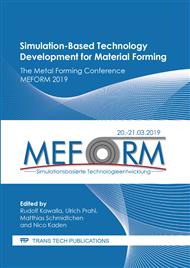[1]
J.-K. Kim, S. Standlöbes, D. Raabe, On the room temperature deformation mechanisms of a Mg-Y-Zn alloy with long-period-stacking-ordered structures, Acta Materialia 82, pp.414-423, (2015).
DOI: 10.1016/j.actamat.2014.09.036
Google Scholar
[2]
J. Yu, Z. Zhang, Q. Wang, X. Yin, J. Cui, H. Qi, Dynamic recrystallization behaviour of magnesium alloys with LPSO during hot deformation, Journal of Alloys and Compounds 704, pp.382-389, (2017).
DOI: 10.1016/j.jallcom.2017.01.321
Google Scholar
[3]
D. Griffiths, Explaining texture weakening and improved formability in magnesium rare earth alloys, Materials Science and Technology 31 (1), pp.10-24, (2015).
DOI: 10.1179/1743284714y.0000000632
Google Scholar
[4]
A. Imandoust, C.D. Barret, T. Al-Samman, K.A. Inal, H. El Kadiri, A review on the effect of rare-earth elements on texture evolution during processing of magnesium alloys, Journal of Materials Science 52, pp.1-29, (2017).
DOI: 10.1007/s10853-016-0371-0
Google Scholar
[5]
H.Z. Li, H.J. Wang, Z. Li, C.M. Liu, and H.T. Liu, Flow Behaviour and Processing Map of As-Cast Mg-10Gd-4.8Y-2Zn-0.6Zr Alloy, Mater.Sci. Eng. A, 528, pp.154-160, (2010).
DOI: 10.1016/j.msea.2010.08.090
Google Scholar
[6]
N. Tahreen, D.F. Zhang, F.S. Pan et al., Characterization of hot deformation behaviour of an extruded Mg–Zn–Mn–Y alloy containing LPSO phase, Journal of Alloys and Compounds, 644, p.814 ff., (2015).
DOI: 10.1016/j.jallcom.2015.04.144
Google Scholar
[7]
J. Wang, F. Xie, S. Liu, S. Huang, F. Pan: Hot Deformation Behaviour and Processing Maps of As-Homogenized Mg-Gd-Y-Zn-Mn Alloy, Rare Metal Materials and Engineering, 47(6), pp.1700-1707, (2018).
DOI: 10.1016/s1875-5372(18)30153-x
Google Scholar
[8]
K. Neh, M. Ullmann, et al.: Mechanical properties and microstructure of the magnesium alloy Mg-6.8Y-2.5Zn-0.5Al produced by casting and hot rolling, Materials Science Forum 918, pp.3-12, (2018).
DOI: 10.4028/www.scientific.net/msf.918.3
Google Scholar
[9]
J. Geng, X. Teng, et al.: Microstructure transformations in the heat-treated Mg-Zn-Y alloy. In: Journal of Alloys and Compounds 577, pp.498-506, (2013).
DOI: 10.1016/j.jallcom.2013.07.009
Google Scholar
[10]
H. Gao, K. Ikeda, T. Morikawa, K. Higashida, H. Nakashima, Analysis of kink boundaries in deformed synchronized long-period stacking ordered magnesium alloys, Materials Letters 146, pp.30-33, (2015).
DOI: 10.1016/j.matlet.2015.01.136
Google Scholar
[11]
H. Liu, J. Ju, X. Yang, J. Yan, D. Song, J. Jiang, A. Ma, A two-step dynamic recrystallization induced by LPSO phases and its impact on mechanical property of severe plastic deformation processed Mg97Y2Zn1 alloy, Journal of Alloys and Compounds 704, pp.509-517, (2017).
DOI: 10.1016/j.jallcom.2017.02.107
Google Scholar
[12]
Y.V.R.K. Prasad, S. Sasidhara, Hot Working guide: A compendium on Processing Maps, ASM International, Metals Park, OH, (1997).
Google Scholar
[13]
Garofalo, Fundamentals of Creep and Creep-Rupture in Metals, McMillan Series in Materials Science, McMillan, New York, (1965).
Google Scholar
[14]
J. Weertman, Dislocation climb theory of steady-state creep, ASM Trans. Quavt. Metal. Sci. Jl, 61, pp.681-694, (1968).
Google Scholar
[15]
Q. Chen, X. Xia, B. Yuan, D. Shu, Z. Zhao, J. Han, Hot workability behaviour of as-cast Mg–Zn–Y–Zr alloy /J/ Materials Science and Engineering A, 593, pp.38-47, (2014).
DOI: 10.1016/j.msea.2013.11.014
Google Scholar
[16]
O.D. Sherby, E.M. Taleff, Influence of grain size, solute atoms and second-phase particles on creep behaviour of polycrystalline solids Materials Science and Engineering A322, p.89–99, (2002).
DOI: 10.1016/s0921-5093(01)01121-2
Google Scholar
[17]
D.R. Lesuer, C.K. Syn, O.D. Sherby, An evaluation of power law breakdown in metals, alloys, dispersion hardened materials, and compounds, in: E.M. Taleff, C.K. Syn, D.R. Lesuer (Eds.), Deformation, Processing and Properties of Structural Materials, p.81–194, (2000).
DOI: 10.1016/s1044-5803(00)00087-5
Google Scholar
[18]
E. Siebel: Die Formgebung im bildsamen Zustande, theoretische Grundlagen der technischen Formgebungsverfahren, Stahleisen, Düsseldorf (1932).
Google Scholar


